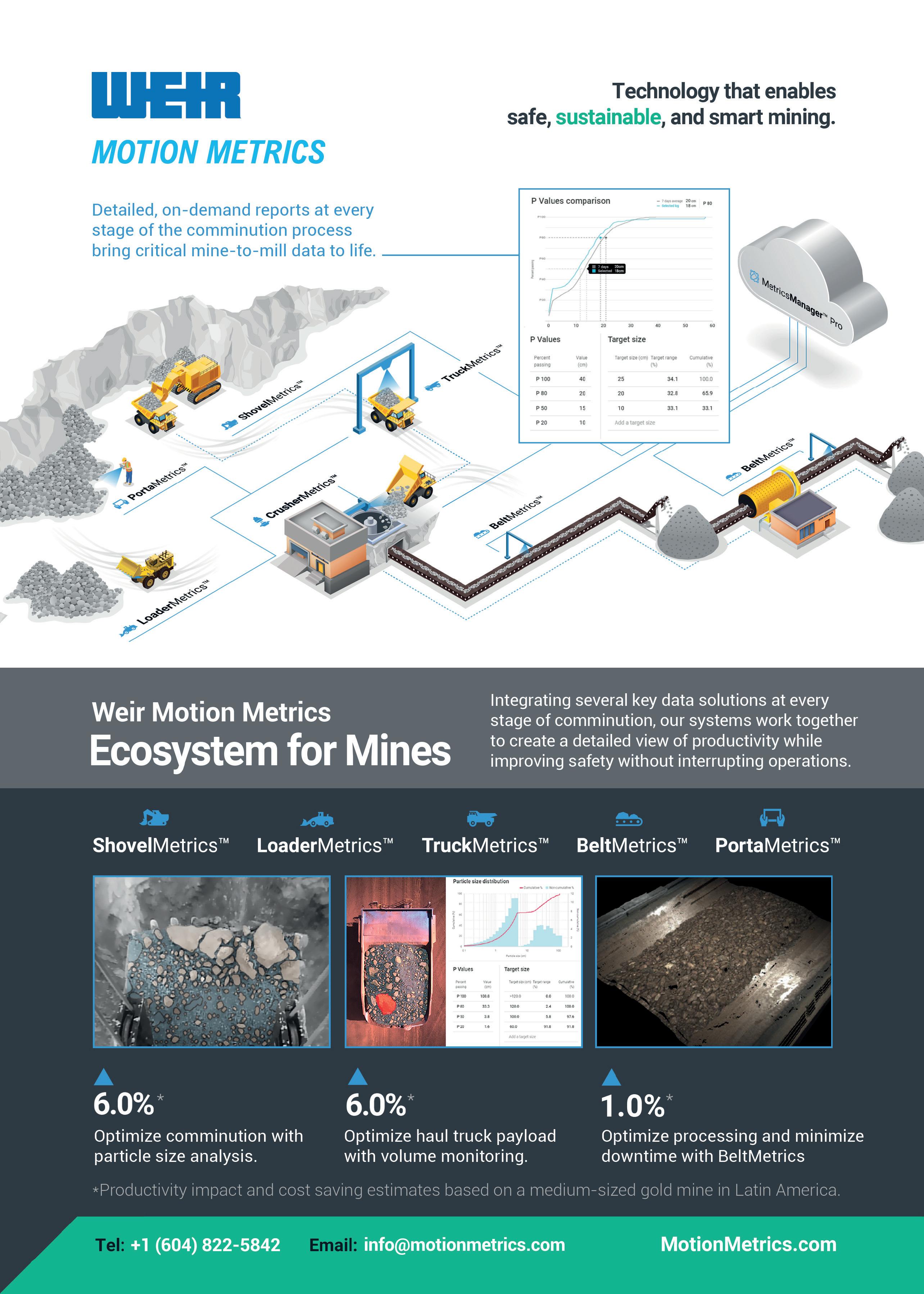
13 minute read
Redefining The Mining Industry
Andrew Swart, Deloitte Touche Tohmatsu Limited, outlines 10 trends that may shape the global mining industry over the next 12 months.
If 2020 set the stage for change in the mining industry, then 2021 cemented its necessity. The ongoing effects of the COVID-19 pandemic on the world of work, along with a continued drive towards digitisation, the growing need to integrate environmental, social, and governance (ESG) commitments with central business functions, as well as the requirement to pivot in response to fast-moving business and operating conditions, have shifted the boundaries that traditionally define how mining companies should look.
Underpinning these drivers is the green energy transition. In November 2021, COP26, held in Glasgow, Scotland, reaffirmed the industry’s importance in supplying the metals central to a low-carbon future.

The Bipartisan Infrastructure Deal, passed by the US Congress in November 2021, is a practical example of how the transition to low-carbon energy and transport technologies is reliant upon critical minerals and metals. The US$1 trillion plan aims to source these primarily from within the US.1 While meeting demand for projects such as these will be a challenge, there is also significant opportunity going forward for businesses to expand their horizons and create new social, environmental, and economic value.
Today, leaders have the chance to reorganise and redefine their company’s purpose and forge partnerships to create a more sustainable and attractive future for the industry. The sky is the limit, and that is why in its 14th year, Deloitte’s ‘Tracking the trends’ report focuses on affecting holistic transformation.2
Deloitte’s experts from across the globe have identified 10 trends that will shape the industry over the next 12 months. The following article provides an overview of each.
Trend 1: Aligning capital allocation to ESG ambitions
While many mining companies have announced ambitious ESG targets over the past five years – decarbonisation being a prime example – most are still grappling with how to move from intent to reality. While much of the focus is currently on climate change, looking to the future, companies should think comprehensively and ensure capital allocation decisions reflect wider ESG commitments.
Investing in a set of businesses, initiatives, and projects that are strategically sound, value-creating, resilient, and sustainable will create portfolios that are advantaged in the minds of investors and shareholders seeking to position mining at the heart of the energy transition.
There are three broad potential portfolio themes to consider. Some companies may prioritise investments geared towards energy management and climate initiatives, specifically those delivering proven economic returns, thus creating an ‘economic decarbonisation portfolio’. On the other hand, there are companies that may choose to invest in longer-term net zero commitments, even though some of these investments may not meet the traditional return thresholds. Similarly, some companies may choose to shift more investment into the wider community, using community impact as a way to de-risk the portfolio long term. This is called the ‘value beyond compliance portfolio’. Finally, some companies may consider creating a more ‘disruptive sustainable portfolio’, with greater emphasis on new business models, new alliances within the value chain, greater levels of innovation, and more sustainable greenfield projects.
In reality, portfolios will contain a mix of elements depending on the long-term vision of the organisation and its appetite for risk. However, it is clear that companies need to factor ESG more explicitly into their capital allocation frameworks going forward.
Trend 2: Reshaping traditional value chains for a low-carbon future
As the green energy transition gets underway, the demands of consumers, suppliers and investors are evolving, and calls for greater transparency in metals supply are increasing. This, combined with a projected shortfall in certain commodities, is starting to reshape value chains, portfolios and business models, as well as ushering new players into the market.
To remain relevant, miners could use their climate change commitments, commodities, and services to tell the story of growing, profitable, and sustainable enterprises; ones that are contributing to societal and environmental needs in a positive manner.
Portfolios are changing with companies scrutinising their assets in relation to the impact that they have on their carbon footprint and ESG rankings. For some companies, a portfolio restructure might be on the cards, while others might divest certain assets and refocus the businesses they have to deliver better value, or balance them with new prospects that offer different types of value.
Demand for critical minerals, particularly rare earth elements, is driving some miners to add commodities to their portfolios. For example, Rio Tinto announced plans to build a tellurium recovery plant at its Kennecott operation near Salt Lake City, Utah, in March 2021.3
Scope three emissions reporting will also inform future supplier and customer choices for mining companies, thus creating new alliances and partnerships up and down the value chain. There will likely be more of these alliances where downstream automotive and industrial companies may either enter into offtake agreements, or take a stake in the resources.
The drive for green and critical minerals is also attracting companies, such as chemical or technology players, into the traditional mining environment. For example, American Battery Technology Co. is creating an extraction and recycling business in the US based around lithium.4 Technology provider, Jetti Resources, is another. The company’s copper extraction technology has attracted investment from the likes of BHP and Freeport-McMoRan.5
Evaluating the impact of operations and products across the value chain is becoming increasingly important, with many companies already looking to enter the circular economy through investments in recycling businesses.
Trend 3: Operating in the new super cycle
2021 saw elevated commodity prices, which heralded the arrival of a new super cycle in mining and metals.6 While this was good news for most miners, with higher metals prices come government demands for a greater share of mineral wealth. As countries began to recover from the COVID-19 induced recession, the mining industry saw various regulatory measures proposed, as well as a rise in resource nationalism.6
Resource nationalism can take many forms. The expropriation of the Kumtor gold mine in Kyrgyzstan from Canadian miner, Centerra Gold, is an overt example of how these measures can create considerable operational as well as financial risk.7
At the regulatory level, Deloitte has observed changes proposed in the tax regimes of key metal producing countries. For example, Chile accounts for 28% of global copper production and is a growing player in lithium.8 Under a proposed bill, investors could face additional tax on the production of key resources.9 Similar trends are seen elsewhere in the world.
Additionally, the international tax system is under reform. In October 2021, using the OECD/G20 Inclusive Framework on BEPS, 136 countries and jurisdictions agreed to implement a plan to tackle tax avoidance. Implementation is expected in 2023 and mining companies must be prepared for change.7
Trend 4: Creating operating models to support ESG commitments
Pressure on mining and metals companies to make high-profile commitments that go above and beyond compliance on ESG issues, such as climate change and tailings management, is mounting. ESG cuts across the whole organisation and the operating model needs to reflect this.
Without proper internal structures in place, companies will find it difficult to make progress towards their ESG commitments or prove to investors and ratings agencies that they are honouring them across the organisation.
At a practical level, this requires an operating model that facilitates visibility, accountability and collaboration between departments, along with a clear governance structure. Operational teams need to be properly connected to corporate strategic initiatives, and there should be clarity on how commitments translate into operational processes and even specific roles within functions.
Information should flow unimpeded up and down the organisational structure, incentives need to be aligned, and leaders must be able to check that the promises they have made publicly are being reflected in practices throughout the organisation.
The risk is that if companies do not test their structures or, if a failure in governance occurs, they could lose an important source of capital or be accused of greenwashing. The latter is not just damaging to an individual company’s reputation, but to the industry as a whole.
Given the opportunities available to the industry, there has never been a more important time to get on top of this.
Trend 5: Positioning companies for an increasingly competitive labour market
Like many industries, the mining sector has felt the lasting effects of COVID-19 on the labour market. The Great Resignation placed additional pressure on a sector which was already challenged by low recruitment numbers.10,11 As a result, many miners have decided to re-evaluate their employee value propositions and transform their ways of working.
Digitisation, remote work practices, establishing greater corporate social purpose and the rearchitecture of work, all provide chances for miners to secure a strategic advantage through human capital going forward.
Aligning with a low-carbon future and promoting the role of mining in the energy transition will help miners to attract and retain employees with the valuable and transferrable skill sets needed to create the digitally enabled, agile businesses of tomorrow. It could also open the doors to new recruits who may not have previously considered a career in mining, boosting diversity, equity, and inclusivity across the board.
Trend 6: Establishing a new paradigm for Indigenous relations
Indigenous communities around the globe no longer want to be positioned as stakeholders in transactional style relationships. They are keen to establish a new type of connection with all entities that participate in their environment, including mining companies.
Issues such as decarbonisation and natural resource management, securing diverse talent, and even leadership are all subsets of how Indigenous peoples can help mining companies better relate to and fulfil their responsibilities as actors within a landscape. If they are willing to listen, there is much that miners could learn from traditional landowners who have lived harmoniously with nature for thousands of years.
By working collaboratively with Indigenous peoples in different countries, in order to align on priorities and advance mutual business strategies and goals, particularly around critical mineral deposits, there is a huge opportunity for mining businesses to alleviate trust issues and secure their social and environmental license to operate.
However, before this can happen, a new paradigm for Indigenous involvement in mining must be established. One that is built upon communication, mutual trust, and respect. This will take time and investment, as well as a shift in governance.
Trend 7: Continuing the journey towards innovation-led organisations
Innovation has been on mining companies’ agendas for some time but, for most, it has proven tricky to integrate the process with the core business functions and operations. Nonetheless, a number of factors have recently converged, causing executives to reconsider their approach.
There is much that the mining industry could learn from other sectors in this regard. For instance, transport and logistics operations often have lower margins than those seen in mining, but are still profitable thanks to greater efficiencies. The agile ways of working employed

in the technology and financial services industries could also offer inspiration.
Leadership is key. Companies that are good at innovating will have a wide risk tolerance, and will allow for production fluctuations when testing an idea that could prove valuable. Successful change starts from the top.
There is also a need to shift away from a culture that focuses only on solving immediate problems and moving towards longer horizon issues. Today, there is the technology, data and visibility to do this, and to become truly agile.
Trend 8: Unlocking value through integrated operations
Mining and metals companies are on a journey to drive efficiencies holistically throughout their organisations. Digital transformation has already contributed to this by enabling real-time visibility from mine to market, but many mining companies have failed to realise the benefits.
The reason is that often too much focus is placed on the technology and not enough on how the organisation will interface with that technology and use it to drive effective integrated decision-making that optimises the system versus an individual function.
The next steps in unlocking value are to use data-based insights to change how decisions are made at every level. Clarifying roles and responsibilities and reviewing incentives can also help. Actions that benefit the organisation as a whole, rather than specific departments or functions, will help companies become nimbler in response to changes in operational and business environments, and create greater value.
Trend 9: Closing the IT-OT cybersecurity gap
The acceleration of information technology (IT) and operational technology (OT) convergence and value chain integration in mining has produced new levels of efficiency in recent years. However, for many companies, rather than security efforts keeping pace with their digital growth, the gap between risks and controls has widened. The result is that, today, some of the industry’s biggest cyber vulnerabilities are around OT, industrial control systems (ICS), and Industrial Internet of Things (IIoT). The ubiquity of digital technologies and work practices mean that businesses now need to factor security threats and solutions into every decision they make.
The adoption of remote and hybrid operating models as ‘the new normal’ also means that now is a good time to review cybersecurity measures around interconnected or segmented networks, and ensure they are robust enough to sustain current practices and support future business growth.
Trend 10: Preparing mining operations for changing climate
While decarbonisation has been the primary focus of miner’s climate change-related efforts thus far, organisations also need to be thinking ahead and building climate resilience across their operations.
Physical risks resulting from climate change can carry significant financial implications for organisations, including direct damage to assets and indirect impacts from supply chain disruption.
By using United Nations climate models and digital risk management tools, it is now possible to quantify physical risks at new and existing mine sites, as well as map supply chains to identify and address pockets of enhanced risk.
The level of transparency and integration seen in mining supply chains today mean that organisations have the chance to not only prepare their own operations, but also help their suppliers and customers ready themselves for whatever operational impacts a changing climate might bring.
The time for change is now
In conclusion, these 10 trends are all closely interwoven. Mining companies should consider them holistically to create competitive and truly sustainable organisations fit to enable a cleaner, greener future.
References
1. TURNER, P. and LEAHY, W., ‘US infrastructure bill is an opportunity mining cannot waste’, FLSmidth Discover Mining, (December 2021), https://www.flsmidth.com/en-gb/discover/mining-2021/ us-infrastructure-bill-is-an-opportunity-mining-cannot-waste, [accessed 12 January 2022]. 2. SWART, A., ‘Tracking the trends 2021’, Deloitte, (2021), https://www2.deloitte.com/global/en/pages/energy-and-resources/ articles/tracking-the-trends.html, [accessed 18 January 2022]. 3. ‘Rio Tinto to build new tellurium plant at Kennecott mine’, Rio Tinto, (8 March 2021), https://www.riotinto.com/en/news/releases/2021/
Rio-Tinto-to-build-new-tellurium-plant-at-Kennecott-mine, [accessed 30 November 2021]. 4. ‘About us’, American Battery Technology Company, (2021) https://americanbatterytechnology.com/about-us/, [accessed 1 December 2021]. 5. STUTT, A., ‘BHP, Freeport invest in Jetti Resources’ ‘holy grail’ copper extraction technology’, Mining.com, (4 June 2021), https://www.mining.com/bhp-freeport-invest-in-jetti-resources-holygrail-copper-extraction-technology/, [accessed 30 September 2021]. 6. ‘Industrial Metals Charge to Fresh Highs as Inflation Runs Hot’,
Bloomberg News, (9 September 2021), https://www.bloomberg.com/ news/articles/2021-09-09/nickel-storms-to-seven-year-high-asdemand-booms-supply-ebbs, [accessed 21 October 2021]. 7. NYER, D., and MARCHILI, S., ‘Mining & metals 2021: Forces of transition and influencers of change’, White & Case, (15 September 2021), https://www.whitecase.com/publications/ insight/mining-metals-2021/new-wave-resource-nationalism, [accessed 21 October 2021]. 8. ‘Centerra Gold Seeks Urgent Relief in International Arbitration to
Prevent the Kyrgyz Republic from Destroying the Integrity, Value and Long-Term Viability of the Kumtor Mine’, Centerra Gold, (27
September 2021), https://s3.amazonaws.com/centerragold/ news/September2021/pY6nBuidRu2J5KN1S6XC.pdf, [accessed 30 November 2021]. 9. ‘Leading copper producers in Chile in 2020, by production volume’,
Statista, (2021) https://www.statista.com/statistics/768692/chilecopper-producers/, [accessed 6 January 2022]. 10. ‘International community strikes a ground-breaking tax deal for the digital age’, OECD, (8 October 2021), https://www.oecd.org/tax/beps/ international-community-strikes-a-ground-breaking-tax-deal-for-thedigital-age.html, [accessed 21 October 2021]. 11. CHUGH, A., ‘What is 'The Great Resignation'? An expert explains’,
World Economic Forum, (29 November 2021), https://www.weforum. org/agenda/2021/11/what-is-the-great-resignation-and-what-canwe-learn-from-it/, [accessed 1 December 2021].










